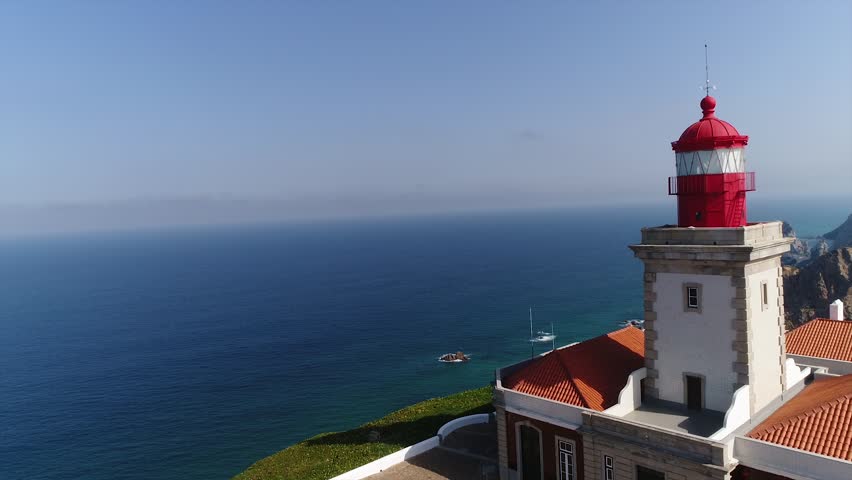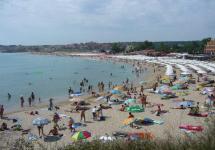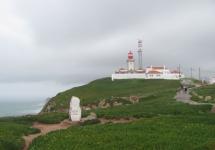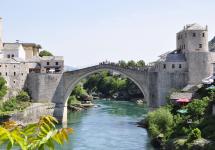Cape Roca in Portugal is the westernmost point of continental Europe, the place where the continent ends and the vast expanses of the Atlantic extend further to America itself. Like many other "extreme" points of the continents, Cape Roca is a place of mass tourist pilgrimage, and like many other "most" (for example) - its "extreme" is rather arbitrary. So, until 1979, Cape Finisterre in Spain was considered the westernmost point of Europe. Plus, if we talk not only about continental Europe, but also about the islands, that is, a lot of places more western than Cape Rock (for example, the west coast of Ireland and other places). Nevertheless, Cape Roca is really an incredibly beautiful place and its romance is felt one hundred percent. This is the place where Europe ends, and if you find yourself here in the evening, you can catch yourself thinking that you are the last European who sees the sun: darkness has already descended on other places, and you are catching the last rays of sunset ...
It is easy to get to Cape Roca from Lisbon - half an hour by train to Sintra, and there bus 403 runs to Cabo da Roca every half hour. This bus runs between Sintra and Cascais and enters the cape on the way.
2. The Atlantic coast is incredibly picturesque here!
8. Directly on the cape there is a memorial sign. This site is always incredibly crowded.
10. There is also a working lighthouse.
12. Cape Roca is a place of mass tourist pilgrimage, but as soon as you step aside, you find yourself all alone in the middle of absolutely stunning protected areas. On the slopes of the surrounding hills, inconspicuous paths lead, which is a pleasure to walk along. One-on-one with magnificent nature, rocks and ocean.
19. After walking a couple of kilometers from Cape Roca, I came across a secluded wild beach surrounded by rocks. Walking down the rocks to the ocean is challenging, but worth it!
21. Half an hour of acrobatics on stones - and we are at the goal!
23. The waves in the ocean are very high and powerful - you need to swim with caution. The water in the ocean, by the way, is cool and almost the same temperature all year round - 18-19 degrees in summer, and 16-17 degrees in winter. Considering that the air heats up almost to 40 in summer, it is extremely pleasant to swim in such water. Invigorates and refreshes. :))
24. After swimming, we will walk with a camera along the coast of this wild bay. Rocks of the most bizarre shapes and outlines, ocean waves, splashes, sand ... Incredibly beautiful!
Views: 3 204
The extreme points of the land have some kind of magical appeal. Such an exciting feeling covers when you stand at the end of the world and in front of you there is only the surface of the water, and behind you is the whole continent. I managed to visit three of the four extreme points of Europe, so today we will go to as many as three countries - Portugal, Spain and Norway.
Geography: Europe is part of the world in the Northern Hemisphere, part of the world's largest continent, Eurasia. If there are no questions with the westernmost, eastern and northernmost point of Europe, since the boundaries of the continent are washed by seas and oceans, and these points have been identified a long time ago, then they could not figure out the easternmost point for quite a long time, because the border between Europe and Asia, passing along the Ural ridge, it is very conditional. Only in 2015, the Institute of Geography of the Russian Academy of Sciences established that the easternmost point is located on the territory of the polar Urals, on Mount Nogodayakha. As far as I know, in nature this place is difficult to access and is not marked in any way, although the authorities of the Yamal-Nenets Autonomous Okrug of Russia have been somehow going to attract tourists there for 3 years.
The most west is Cape Roca.
The westernmost point of Europe is located 40 kilometers from the capital of Portugal, Lisbon, at Cape Roca (Cabo da Roca). On a 140-meter cliff overlooking the Atlantic Ocean, there is a lighthouse, a large stone cross and a memorial stone.

The stone is inscribed with the words of the Portuguese poet Luis Camões: “This is the place where the land ends and the sea begins”, as well as the coordinates of this place. Walking paths are laid around, there is a souvenir shop and a cafe.
Majestic cliffs drop right into the ocean.

This place is especially popular at sunset hours. Unfortunately, it is always very windy on the cape, so you won't walk here for a long time.

You can get to Cape Roca from the nearby town of Sintra by bus or by private car.
The southernmost cape of Morocca.
The southernmost point of Europe, Cape Morocca (or Cape Tarifa), is located on the outskirts of the city of Tarifa in Spain. It is a tiny islet of Las Palomas, which is connected by a dam to the mainland.

Interestingly, the border between the Atlantic Ocean and the Mediterranean Sea also lies at this place. In the photo, the ocean is on the right, and the sea is on the left.
It is also the narrowest point of the Strait of Gibraltar. Africa is only 14 kilometers away!

Unfortunately, access to the islet of Las Palomas is closed to the public, as there is an old fortress, which now houses a military unit.

But tourists can take pictures next to the information stands at the end of the dam.

You can get here on foot from the town of Tarifa. On the way, I advise you to wrap up for a swim at the excellent beaches.

The most north is Cape Nordkin.
Many people mistakenly believe that the northernmost point in Europe is at the North Cape, but this is not the case. After all, the North Cape is located on an island, and the more northern islands, for example, Svalbard, belong to Europe. If we are talking about continental Europe, then its northernmost point is located at Cape Nordkin in Norway.

Unlike the "convenient" tourist North Cape, where there is a good entrance, a parking lot, a monument and a souvenir shop, getting to Cape Nordkin is not so easy. From the nearest parking you will have to walk 24 km along completely deserted places, deer trails and rocky fields. The hike will take at least 7 hours one way at a brisk pace.
The beginning of the path is marked with such gates, and then you will have to navigate by GPS and stone posts indicating the route.

Most likely, you will not meet anyone other than reindeer on your way.

The landscapes around along the way are a different planet!

Even at the height of summer, there is snow in some places, and the temperature rarely rises above 10 degrees.
But the sun never sets over the horizon in summer!

The second option is to try to get to Cape Nordkin by water, but it is rather difficult to land on the shore near it. Due to the surf waves in the Sandefjord Bay, it will most likely not be possible to dock normally, and the Barents Sea in those parts is icy even in summer.

Personally, I have tried both options and would certainly recommend the hike (for those who love wilderness and harsh conditions).
Before the hike, you need to inform people in the nearby village of Mehamn that you are going on a journey and inform when you plan to return. Mobile communication at the end of the world is practically absent and in case of force majeure it is good if someone knows what to look for you. You can get to Mehamn by your own car or with numerous transfers by plane.
The westernmost point of Eurasia in general, and Europe in particular, is located in the capital of Portugal, Lisbon, in the Sintra-Cascais National Park (originally Sintra-Cascais Natural Park). This point is known throughout the world as Cape Rock. But to be more precise, in fact, Cape Roca is located west of Lisbon and is not included in the city limits. Although the residents of the capital often call it the Cape of Lisbon, thereby constantly reminding where exactly it is located, and so that no one has the question "Where is the westernmost point of Eurasia after all?"
Cape Roca on the map
- Geographic coordinates (38.780491, -9.498952)
- Distance from the center of the capital of Portugal Lisbon about 33 km in a straight line
- The nearest airport is Cascais, west of Lisbon, approximately 14 km
The famous local poet Luis Camões, who lived in the 16th century, called Cape Roca the place where “the land ends and the sea begins”. This is indeed the case. Here the largest continent of the planet ends and the most elongated ocean of the planet begins.
Arriving here, know, beyond Cape Roca, there is only the endless Atlantic Ocean. It is for this that tourists constantly come here, for the opportunity to visit the end of the world and look beyond it.
Cape Rock, like the Cape of Good Hope, is a rocky outcropping into the ocean, towering 140 meters above it. But from the shore, this height is not felt, since the entire space in front of you is filled with the blue sky and the blue ocean. The coastline around the Cape is a mixture of sandy beaches and rocky cliffs. The rocks in these places are worthy of special attention.

Directly on the very Cape of Roca, there is a stone stele with a plate on which its coordinates are indicated.

In addition, the surroundings will definitely delight you with their beautiful views. Photos of the ocean in these places are unforgettable. But be careful, huge bodies of water blur the edge of reality and create the illusion of the closeness of the ocean. Let us remind you once again - the height of the rock is practically not felt here. Therefore, when trying to take spectacular pictures, follow basic safety rules. A good photo isn't worth your life. Unfortunately, tragic incidents have been recorded at Cape Roca in which people have died trying to take extreme photographs. Now the most dangerous places are fenced off, which does not always stop candidates for the "Darwin Prize" (if you don't know, this is a virtual prize for the most ridiculous way to die).
In the vicinity of Cape Roca, you can see an old lighthouse located at an altitude of 165 meters above sea level and built in 1772. This is the first lighthouse built in Portugal. After reconstruction in 1842, the lighthouse acquired the form that you can now see live directly on Cape Roca or in photographs. The power of the beacon beam is 1 kW. It can be seen from a distance of 46 kilometers.

Cape Roca as a tourist site
Access to Cape Roca is free, as is car parking nearby. The visiting time is not limited, but, as practice shows, usually tourists spend no more than an hour here, as the constant strong wind “drives out” even the most persistent tourists from here. The best time to visit is sunset. Falling over the horizon, the goodbye sun gives travelers unforgettable views.
- After you get bored of your homeland and are going to return, be sure to receive a special certificate of visiting Cape Roca. You can buy it for a few euros in one of the shops. It is allowed to enter several people in one certificate, but it is better to take a personalized certificate, because after visiting the end of the world (in the literal sense of the word), you want to leave an individual memory about it
- In ancient times, the inhabitants of the Roman Empire called Cape Roca Promontorium Magnum. And in the era of the Sail (sometimes it is considered the beginning of the era of the Great Geographical Discoveries), this place was known as the Rock of Lisbon
Cape Roca photo

Cape Roca or Cabo da Roca is the edge of Europe and if you are in Portugal you should definitely visit the westernmost point of continental Europe.
Cape Roca is an important landmark for sailors. Until the end of the 14th century, all Europeans considered the end of the earth, after which an immense ocean begins. Indeed, you might think so, especially when you see the raging waters of the Atlantic Ocean, huge waves hitting the rocks and fountains of spray flying on small footpaths along the coast.
Cape Roca is amazing and after visiting one of the many souvenir shops you can buy a certificate certifying that its owner was at the “end of the earth”:

The cliffs hang 150 meters above the ocean, and from this point you can enjoy panoramic views of the coastline and the Serra De Sintra massif.
Historical records say that in the sixteenth century there was a fort on this site, which played an important role in protecting the sea approaches to Lisbon, forming a protective line of the coast. All that remains of the fort today is some ruins and a lighthouse. The lighthouse, however, has already been modernized, and it still serves for ships sailing in these waters.
The cape is part of the Sintra-Cascais nature reserve, it is he who is of greatest interest to tourists visiting these places.
Cape Roca on the map
The excursion itself does not last long, because here on the cape there is only a lighthouse, rocks, and souvenir shops. On average, the excursion route takes one hour - this is a visit to the lighthouse and several viewing platforms for exploring Cape Roca. Then one more hour for souvenirs and warm drinks (tea, coffee) in the nearest coffee.
How to get to Cape Roca?
Cape Roca is located 18 kilometers west of the city of Sintra and 40 kilometers from Lisbon. The easiest and fastest way to get to Cabo Roca is by renting a car.
 If you are going to Portugal to see Cape Roca, then you need to get or less.
If you are going to Portugal to see Cape Roca, then you need to get or less.
Food prices on the Iberian Peninsula are about the same, you can compare with.
And if you love such interesting places, then you probably will not give up the extreme either -
There is also public transport from the city of Sintra - bus 403, which costs 4 euros, and the journey will take 40 minutes. The bus runs every hour in both directions from 9 am to 7 pm. But the schedule is not regular, but depends on the season, so it is better to check on the spot.

Taxis can be taken for 35 euros, and the journey takes about 25 minutes, so if you have a group of four, then there is a reason to take a taxi and go in comfort.
- The first lighthouse on this site was built in 1772, but the current lighthouse has been standing since 1842, and its 1000 watt light is visible from 46 kilometers;
- There are very few plants in this part of the coast that grow in the interior of Portugal. This is due to the fact that the constant strong winds from the ocean carry with them salt, which kills many plants;
- The cape is marked by a stone monument with a cross on top. The inscription on the monument is a quote from the famous Portuguese poet Luis Camões (1524-1580): "Where the land ends and the sea begins".

The pedestal on which the quote is carved
Once the most influential empire in the world, Portugal has already lost its former greatness, but this place has retained it. In those ancient times, in the era of great geographical discoveries, ships sailed from the coast of Portugal to the unexplored distances, and the last thing they saw was Cabo Roca or the end of the earth.
Cape Roca (Cabo da Roca)- a narrow granite cliff 144 meters high on the Atlantic coast, located in the municipality of Sintra, about 65 kilometers west of the capital city. The cliff is crowned with an observation deck with a commemorative sign on which the coordinates are engraved - 38º47 'north latitude and 9º30' west longitude, as well as the words of the Portuguese poet Luis Camões: "This is the place where the land ends and the sea begins."
Cape Roca is the westernmost point of continental Europe, a place that was once seriously considered the "end of the world." The promontory is the western end of the Sintra mountain range and completes a 30-kilometer stretch of coastline known as the Portuguese Riviera. This stretch of the Atlantic coast is amazingly beautiful, the landscapes are rapidly changing from high, steep cliffs to the ocean to quiet lagoons with beautiful white sand beaches. On sunny days, you can see Meco Beach from the top of the cliff (Praia do Meco), which is located 45 kilometers from Cape Roca.
Not far from the sign and the observation deck, there is a lighthouse built back in 1772. It is still operational and maintained by a team of three overseers. The lighthouse's lamps are 150 meters above the ocean, which means that 1000-watt light is visible at a distance of 46 kilometers. Historical evidence suggests that there was a fort at Cape Roca in the 17th century, which played an important role in guarding the entrance to the harbor of Lisbon, providing a defensive line along the coast. Today, only minor traces of the fortress remain, as well as a lighthouse, which is still an important navigation object.
Due to its outstanding natural beauty and historical significance, Cape Roca is part of the Sintra-Cascais Natural Park (Parque Natural de Sintra-Cascais), one of the 13 natural parks in Portugal.
Cape Roca: How to get there
Portela International Airport closest to Cape Roca (Lisbon Portela Airport) located in Lisbon. From Lisbon to Cape Roca can be reached via Sintra (Sintra) or Cascais (Cascais).
Buses 783 and 744 leave from the airport every 5 minutes to Lisbon Entrecampos Train Station (Estação de Entrecampos)... Ticket price - 2 EUR, travel time - 18 minutes. From the station "Entrecampos" to Sintra, trains leave every 15 minutes, the ticket price is from 2 to 4 EUR, travel time - 38 minutes.
Sintra can be reached directly from the airport by taxi. Such a trip will take about 20 minutes and cost an average of 45 to 60 EUR. Renting a car at Lisbon airport will cost an average of 70 to 100 EUR per day, excluding the cost of fuel.
To get from Lisbon airport to Cape Roca via Cascais, you need to take bus route number 1 at the airport, which departs every 20 minutes, the ticket costs 6 EUR. In half an hour you will arrive at the Cais do Sodre train station (Lisboa Cais do Sodre), from where trains leave every 15 minutes to Cascais. The ticket price is 2-4 EUR, travel time is 40 minutes.
From Sintra and Cascais to Cape Roca, public transport is quite convenient, as the bus stop is on the main bus route 403 Sintra - Cascais. The ticket costs 4 EUR. The journey from Sintra takes 40 minutes, from Cascais 25 minutes. Buses run in both directions every hour from 9:00 am to 5:00 pm, but the interval during the day may change slightly, so it is worth checking the local bus schedule before leaving.
You can take a taxi from Cascais; a trip with a 30-minute wait costs an average of 35 EUR.
Cape Roca: Life Hacks
There is no admission fee for the observation deck or parking at Cape Roca. Most visitors spend here from half an hour to an hour, admiring the view of the ocean, examining the rocks, the monument and the lighthouse, and, of course, taking beautiful photographs. As a rule, you want to stay in this place longer, but the constant and very strong wind gets in the way. The best time to visit is in the evening, when you have the opportunity to see the sun set over the ocean. This is truly an amazing sight, but, unfortunately, only accessible to those who come by car. It should be remembered that buses to Sintra and to Cascais only run until 17.00.
In addition to the lighthouse and observation deck, there is a small coffee shop on the headland where you can hide from the wind and have a cup of coffee, as well as a gift shop. To commemorate your visit, here you can purchase a personalized and handwritten certificate confirming that you have actually visited Cape Roca. The price of the basic certificate is 5.60 EUR, while the more complex version costs 11 EUR.
If you have reached Cape Roca, then do not miss the opportunity to see the sights of Sintra and Cascais. In Sintra you will find exquisite palaces, extravagant villas and magnificent ornamental gardens. A variety of unique historical monuments combined with picturesque landscapes make a walk around the city truly unforgettable. Cascais is not only a cozy old town with architectural monuments of the 19th century and typical Portuguese national color, it is also a popular resort with excellent sandy beaches and high waves - a dream for surfers.



